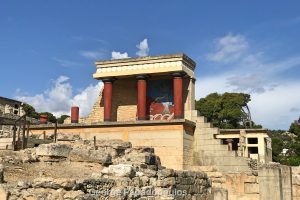
The Palace of Knossos is located in the outskirts of Heraklion and is one of the most popular ones in Greece. Don’t miss the chance to visit one of the most important prehistoric sites in Europe. It is the most important archaeological site on the island of Crete. It is the oldest palace in Europe and one of the four Minoan palaces. In prehistoric times it was surrounded by an extensive city. The Palace was built on a low hill. The choice of location and the subsequent growth of the settlement are connected with its proximity to the sea and the fertile earth of the region. The site was first settled in the Neolithic period (7000-3200 BCE). The First Palace (also known as the Old Palace) was built around 1900 BCE. The basic plan was formed during that time. It was destroyed around 1700 BCE and the New Palace was built in its place (New Palace Period). The Palace of Knossos was used even after 1450 BCE when the rest of the Cretan palaces were destroyed. Most experts believe that new inhabitants from the Mycenaean Greek Mainland were installed in the Palace. The Palace ceased to function after 1380 BCE.
The Palace displays sophisticated architectural features: beams incorporated in the walls against the earthquakes, light wells for the ventilation, multi-storied buildings, walls covered with polished gypsum, huge storerooms and even a theatre! A great variety of materials is attested: slabs of green schist for floors, wooden columns, gypsum slabs on walls, floors and elsewhere. These fragile materials are though susceptible to weathering. Multi-coloured plaster and wall paintings contributed to room decoration.
The Palace appears to have been the centre of political, economic and religious authority. The legendary king of Knossos was Minos, son of Zeus and Europa. The palace, having 1,300 rooms and a surface of 22,000 m2, is the labyrinth of Greek Mythology.
The excavation of Knossos
Excavations first took place in 1878 when Minos Kalokairinos uncovered part of the West Wing of the Palace. Systematic excavations began in March 1900 under Arthur Evans, then Director of the Ashmolean Museum in Oxford. Two years later, the excavation of the Palace had almost been completed. Excavations though continued until 1931. After World War II the British School of Archaeology continued the excavations in the area.
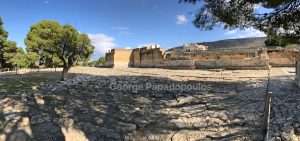
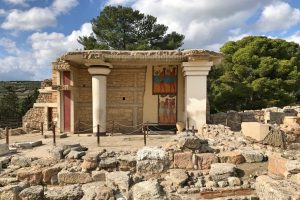
The restoration of Knossos
The need for conservation of the Palace was obvious from the beginning of the excavation. In 1905, Evans and his colleagues confined themselves to protecting the ruins. However, after 1925, Evans started a mass-scale reconstruction of the site using concrete. Floors and whole architectural units were reconstructed. The wall paintings were restored and copies set up at different points. Evans’s reconstructions are largely irreversible but today they are a part of the monument and its history.

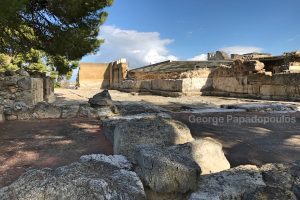
West court & West facade
The court is crossed by the so-called “Processional Causeways”, which stand out from the rest of the paving. One idea is that processions were used during rituals. The West Facade of the Palace is constructed of massive gypsum blocks.

The corridor of the procession
This was a roofed area opening onto the West court, supported by one column of which part of the gypsum base remains. The corridor is so named from the wall painting (the original is in the Heraklion Archaeological Museum) decorating its east wall and depicting a procession of people holding gifts. The “corridor of the procession”, according to Evans, initially went to the “South Propylaeum” and continued on to the Central Court.
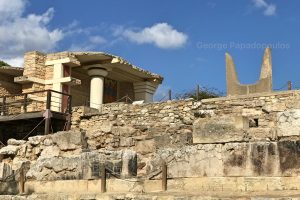
The main entrance of Knossos: the “South Propylaeum”
The “South Propylaeum” was restored by of Evans who put up a copy of the “Cup-Bearer” fresco here. The wall painting depicted a man holding a libation vase (the original is in the Heraklion Archaeological Museum). The large storage jars on the east side of the Propylaeum belong to the Postpalatial Period (1450-1100 BCE), and indicate that this area was used for storage in later times.
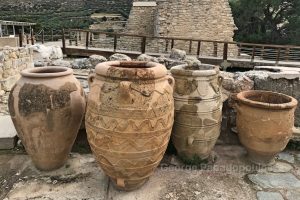
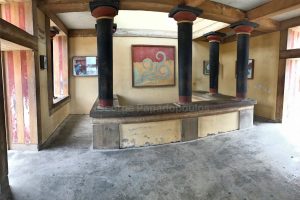
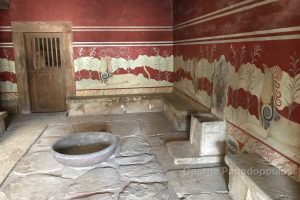
The “Throne Room”
Nowadays the visitor can enter only in the antechamber of the so-called “Throne Room”. Its name comes from the stone seat found in the room behind the antechamber. Stone benches are preserved in the antechamber, as well as in the “Throne Room” itself. Pieces of fresco depicting plants and griffins were found in this room (the original is in the Heraklion Archaeological Museum).
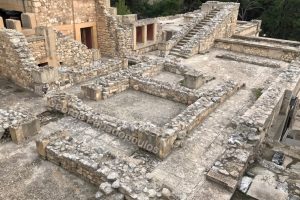
The East Wing of Knossos
This is one of the most impressive parts of the palace because two storeys are preserved below the level of the Central Court. Evans, who believed that the Palace was the seat of the king of Knossos, believed that the royal quarters of Knossos lay in this part of the site.
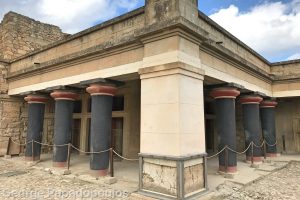
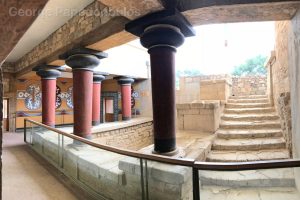
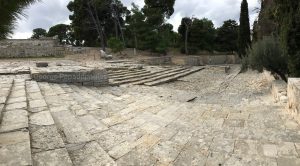
The “Theatral area” and the “Royal Road”
This area is known as called the “Theatre”. It is a platform and rows of steps that form an angle. At the bottom of the steps is the end of a narrow raised road that divides a paved court. The raised paved road continues in the opposite direction. It passes underneath the modern road to Herakleion connecting the Palace with the Minoan town, which extended to the West and North. Evans named the road the “Royal Road”.
A visit at the Palace will offer you the opportunity to discover the first advanced European civilization!
Official web-site of the Ministry of Culture: http://odysseus.culture.gr
Telephone: +30 2810 231940
Fax: +30 2810 322570
Email: efahra@culture.gr
Tickets: Full: €15, Reduced: €8
Knossos + Heraklion Archaeological Museum tickets: Full: €16, Reduced: €8
Reduced admission for:
Escorting parents on educational visits of primary schools.
Greek citizens and citizens of other Member – States of the European Union who are over 65 years old, upon presentation of their ID card or passport for verification of their age and country of origin.
Students of University – Higher Education Institutes, Technological Educational Institutes or equivalent Schools of countries from outside the European Union, upon presentation of their student ID cards
Free admission days
6 March
18 April
18 May
The last weekend of September annually
28 October
Every first Sunday from November 1st to March 31st